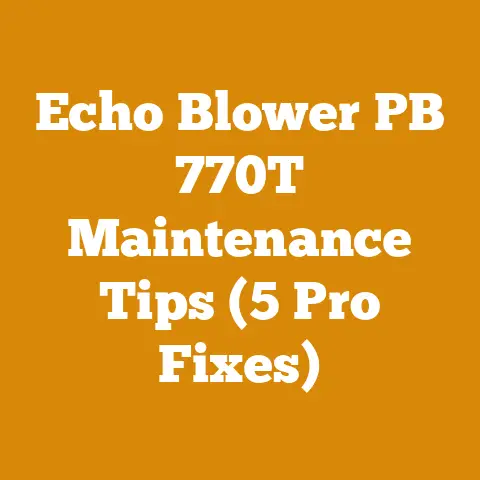What Is the Best Cordless String Trimmer? (Pro Tips for Precision)
Let’s talk about string trimmers. For years, I wrestled with gas-powered trimmers – the noise, the fumes, the constant struggle to get them started. Then I made the switch to cordless, and it was a game changer. I’m not just talking about convenience, but also about precision and efficiency in managing the edges of my property, especially around my wood piles and newly planted trees. A good cordless string trimmer isn’t just for trimming grass; it’s a vital tool for maintaining a clean and safe working environment when dealing with wood processing and firewood preparation. Choosing the right one, however, requires careful consideration. This guide will walk you through everything you need to know, from understanding the different types to mastering the techniques for achieving professional-level results.
The Cordless String Trimmer Upgrade: Why It Matters
The shift to cordless power tools has revolutionized many aspects of wood processing and land management. I’ve seen firsthand how cordless chainsaws have simplified limbing tasks, and cordless leaf blowers have made clearing debris around the wood splitter much faster. The same holds true for string trimmers. Upgrading to a cordless model offers several key advantages:
- Reduced Noise and Emissions: Gas-powered trimmers are notoriously loud and produce harmful emissions. Cordless models are significantly quieter and emit no fumes, making them a more environmentally friendly and user-friendly option. This is especially important if you’re working in residential areas or have noise sensitivities.
- Increased Convenience and Portability: No more dealing with gas cans, mixing fuel, or pulling starter cords. Cordless trimmers are lightweight, easy to start, and can be used anywhere on your property without the need for extension cords. This portability is crucial when you’re working in remote areas or dealing with large properties.
- Improved Precision and Control: Many cordless trimmers feature adjustable speed settings and lightweight designs, allowing for greater precision and control when trimming around delicate plants, fences, or wood piles. I’ve found this particularly helpful when cleaning up around my stacked firewood, preventing damage to the wood and maintaining a neat appearance.
- Lower Maintenance Costs: Cordless trimmers require less maintenance than gas-powered models. There are no carburetors to clean, spark plugs to replace, or oil changes to perform. This translates to lower operating costs and less downtime.
Understanding Cordless String Trimmers: Key Concepts
Before diving into the specifics of choosing the best cordless string trimmer, let’s define some key terms and concepts:
- Voltage: Voltage (V) indicates the power of the battery. Higher voltage generally translates to more power and longer run times. Common voltage options for cordless string trimmers include 18V, 20V, 40V, 60V, and 80V.
- Amp-Hours (Ah): Amp-hours (Ah) represent the battery capacity. Higher amp-hours mean longer run times. For example, a 5.0Ah battery will typically provide longer run times than a 2.0Ah battery.
- Cutting Swath: The cutting swath refers to the width of the area the trimmer can cut in a single pass. Wider cutting swaths allow you to cover more ground quickly, but they may also reduce run time.
- Line Feed Mechanism: The line feed mechanism determines how the trimmer line is advanced. Common types include:
- Bump Feed: The user bumps the trimmer head on the ground to advance the line.
- Automatic Feed: The trimmer automatically advances the line as needed.
- Fixed Line: The user manually advances the line.
- Brushless Motor: Brushless motors are more efficient, durable, and powerful than brushed motors. They also tend to be quieter and require less maintenance.
- Green Wood vs. Seasoned Wood: While not directly related to string trimmers, understanding the difference between green wood and seasoned wood is crucial for anyone involved in firewood preparation. Green wood is freshly cut wood with high moisture content, while seasoned wood has been dried to a lower moisture content, making it easier to burn. String trimmers are often used to maintain the areas around wood piles, regardless of whether the wood is green or seasoned.
Step-by-Step Guide to Choosing the Best Cordless String Trimmer
Choosing the right cordless string trimmer depends on your specific needs and budget. Here’s a step-by-step guide to help you make the best decision:
Step 1: Assess Your Needs
- Property Size: How large is the area you need to trim? If you have a small yard, a lower voltage trimmer with a smaller battery may suffice. For larger properties, you’ll need a higher voltage trimmer with a larger battery capacity.
- Type of Vegetation: What kind of vegetation will you be trimming? If you’re only dealing with grass, a basic trimmer will do. If you need to cut through thicker weeds or brush, you’ll need a more powerful trimmer with a thicker line.
- Frequency of Use: How often will you be using the trimmer? If you only need to trim occasionally, a less expensive model may be sufficient. If you plan to use the trimmer frequently, it’s worth investing in a higher-quality model that will last longer.
- Budget: How much are you willing to spend? Cordless string trimmers range in price from around \$100 to \$500 or more. Set a budget before you start shopping to avoid overspending.
Step 2: Consider Voltage and Battery Capacity
- Voltage: For light-duty trimming around the yard, an 18V or 20V trimmer may be sufficient. For heavier-duty tasks, such as cutting through thick weeds or brush, consider a 40V, 60V, or 80V trimmer.
- Battery Capacity: Choose a battery capacity that matches your needs. A 2.0Ah battery may be sufficient for small yards, while a 5.0Ah or larger battery is recommended for larger properties. Keep in mind that higher voltage trimmers often require larger batteries to deliver optimal performance.
Step 3: Evaluate Cutting Swath and Line Feed Mechanism
- Cutting Swath: A wider cutting swath allows you to cover more ground quickly, but it may also reduce run time. Choose a cutting swath that’s appropriate for the size of your yard and the type of vegetation you’ll be trimming. Common cutting swaths range from 10 inches to 16 inches.
- Line Feed Mechanism: Consider the type of line feed mechanism that’s best for you. Bump feed is the most common type, but automatic feed can be more convenient. Fixed line trimmers are less common but can be useful for specific applications. I personally prefer bump feed for its simplicity and reliability.
Step 4: Look for a Brushless Motor
- Brushless motors are more efficient, durable, and powerful than brushed motors. They also tend to be quieter and require less maintenance. While trimmers with brushless motors are typically more expensive, the added durability and performance makes it worth the investment.
Step 5: Check for Ergonomic Design and Features
- Weight: Choose a trimmer that’s lightweight and comfortable to hold. A heavy trimmer can be tiring to use, especially for extended periods.
- Adjustable Handle: Look for a trimmer with an adjustable handle that allows you to customize the grip for optimal comfort and control.
- Telescoping Shaft: A telescoping shaft allows you to adjust the length of the trimmer to suit your height.
- Edging Function: Some cordless string trimmers feature an edging function that allows you to easily convert the trimmer into an edger for creating clean, professional-looking edges along sidewalks and driveways.
Step 6: Research Brands and Models
- Read online reviews and compare different brands and models. Consider the reputation of the manufacturer, the warranty offered, and the availability of replacement parts.
- Ask friends, neighbors, or other professionals for recommendations. Their firsthand experiences can be invaluable.
Step 7: Consider the Battery Platform
- If you already own other cordless tools from a particular brand, it may make sense to choose a string trimmer that uses the same battery platform. This will allow you to share batteries between tools, saving you money and reducing clutter.
Step 8: Test Before You Buy (If Possible)
- If possible, try out the trimmer before you buy it. This will allow you to get a feel for its weight, balance, and ease of use.
Detailed Tool Specifications and Measurements
To help you make an informed decision, here are some detailed tool specifications and measurements for common cordless string trimmers:
| Brand & Model | Voltage (V) | Amp-Hours (Ah) | Cutting Swath (in) | Line Feed Mechanism | Motor Type | Weight (lbs) | Price (USD) |
|---|---|---|---|---|---|---|---|
| DeWalt DCST920P1 | 20 | 5.0 | 13 | Bump Feed | Brushless | 8.5 | \$199 |
| EGO Power+ ST1521S | 56 | 2.5 | 15 | Bump Feed | Brushless | 7.3 | \$229 |
| Greenworks 40V 13-Inch String Trimmer | 40 | 2.0 | 13 | Automatic Feed | Brushed | 6.2 | \$129 |
| Ryobi ONE+ HP Brushless 18V String Trimmer | 18 | 4.0 | 11-13 (Adjustable) | Bump Feed | Brushless | 7.5 | \$179 |
| Milwaukee M18 FUEL String Trimmer | 18 | 8.0 | 16 | Bump Feed | Brushless | 9.1 | \$299 |
These specifications can help you compare different models and choose the one that’s best suited for your needs. For example, if you have a large property and need a trimmer with a long run time, the Milwaukee M18 FUEL String Trimmer with an 8.0Ah battery might be a good choice. If you’re looking for a lightweight and affordable option for light-duty trimming, the Greenworks 40V 13-Inch String Trimmer might be a better fit.
Techniques for Precision Trimming: Pro Tips
Once you’ve chosen the right cordless string trimmer, it’s time to learn the techniques for achieving professional-level results. Here are some pro tips:
- Wear Safety Gear: Always wear safety glasses, hearing protection, and gloves when operating a string trimmer. Long pants and closed-toe shoes are also recommended.
- Start with a Fresh Line: Replace the trimmer line regularly to ensure optimal cutting performance. A dull or frayed line can tear and shred grass instead of cutting it cleanly.
- Use the Right Line Size: Use the line size recommended by the manufacturer. Using a line that’s too thick can damage the trimmer head and reduce run time.
- Trim in Small Increments: Avoid trying to cut too much grass or weeds at once. Trim in small increments to prevent the trimmer from bogging down and to achieve a cleaner cut.
- Overlap Your Passes: Overlap your passes slightly to ensure that you’re cutting all of the grass and weeds.
- Maintain a Consistent Height: Hold the trimmer at a consistent height to achieve a uniform cut.
- Use the Edging Function: If your trimmer has an edging function, use it to create clean, professional-looking edges along sidewalks and driveways.
- Clean the Trimmer After Each Use: Clean the trimmer head and motor housing after each use to remove debris and prevent buildup.
- Store the Trimmer Properly: Store the trimmer in a dry, protected location to prevent damage. Remove the battery before storing the trimmer for extended periods.
Case Study: Trimming Around Firewood Stacks
One of the most common applications for a cordless string trimmer in my wood processing operation is trimming around firewood stacks. Keeping the area around my stacks clear of weeds and grass helps to prevent the spread of insects and diseases, and it also makes it easier to access the wood.
Here’s how I use my cordless string trimmer to maintain my firewood stacks:
- Preparation: Before starting, I clear any large debris, such as branches or rocks, from the area around the stacks.
- Trimming: I use my cordless string trimmer to trim the grass and weeds around the base of the stacks, working in small increments and overlapping my passes.
- Edging: I use the edging function on my trimmer to create a clean edge along the perimeter of the stacks.
- Cleanup: After trimming, I use a leaf blower to remove any remaining debris from the area.
This simple process helps me to keep my firewood stacks looking neat and organized, and it also helps to protect the wood from pests and diseases.
Safety Considerations
Safety is paramount when operating any power tool, including a cordless string trimmer. Here are some important safety considerations:
- Read the Owner’s Manual: Always read and understand the owner’s manual before operating the trimmer.
- Wear Safety Gear: Always wear safety glasses, hearing protection, and gloves when operating the trimmer.
- Inspect the Trimmer: Before each use, inspect the trimmer for any signs of damage or wear.
- Clear the Area: Before starting, clear the area of any obstacles, such as rocks, branches, or toys.
- Keep Children and Pets Away: Keep children and pets away from the work area.
- Avoid Overreaching: Avoid overreaching or working in awkward positions.
- Use the Trimmer in a Well-Ventilated Area: If you’re using a gas-powered trimmer, use it in a well-ventilated area to avoid inhaling fumes.
- Store the Trimmer Properly: Store the trimmer in a dry, protected location to prevent damage.
- Unplug or Remove the Battery: Always unplug the trimmer or remove the battery before performing any maintenance or repairs.
Benefits and Strategic Advantages
Using a cordless string trimmer in your wood processing or firewood preparation operation offers several benefits and strategic advantages:
- Improved Efficiency: Cordless trimmers are lightweight, easy to start, and can be used anywhere on your property, allowing you to trim quickly and efficiently.
- Reduced Labor Costs: By streamlining the trimming process, you can reduce labor costs associated with maintaining your property.
- Enhanced Safety: Keeping the area around your wood piles clear of weeds and grass helps to prevent accidents and injuries.
- Improved Aesthetics: A well-maintained property looks more professional and inviting.
- Environmental Benefits: Cordless trimmers produce no emissions, making them a more environmentally friendly option than gas-powered models.
- Versatility: Cordless string trimmers can be used for a variety of tasks, including trimming grass, weeds, and brush, as well as edging sidewalks and driveways.
Costs, Material Specs, Timing Estimates, and Skill Levels
Here’s a breakdown of the costs, material specs, timing estimates, and skill levels associated with using a cordless string trimmer:
- Costs: The initial cost of a cordless string trimmer can range from \$100 to \$500 or more, depending on the brand, model, and features. You’ll also need to factor in the cost of replacement line and batteries.
- Material Specs: The trimmer line is typically made of nylon or other synthetic materials. The diameter of the line ranges from 0.065 inches to 0.105 inches.
- Timing Estimates: The amount of time it takes to trim an area depends on the size of the area, the type of vegetation, and the skill of the operator. A small yard can typically be trimmed in 15-30 minutes, while a larger property may take several hours.
- Skill Levels: Operating a cordless string trimmer is relatively easy, and most people can learn the basics in a few minutes. However, mastering the techniques for achieving professional-level results requires practice and experience.
Practical Next Steps and Implementation Guidance
Ready to start using a cordless string trimmer in your wood processing or firewood preparation operation? Here are some practical next steps and implementation guidance:
- Assess Your Needs: Determine the size of the area you need to trim, the type of vegetation you’ll be trimming, and your budget.
- Choose the Right Trimmer: Use the information in this guide to choose the best cordless string trimmer for your needs.
- Purchase the Trimmer: Purchase the trimmer from a reputable retailer or online store.
- Read the Owner’s Manual: Before operating the trimmer, read the owner’s manual carefully.
- Gather Your Safety Gear: Gather your safety glasses, hearing protection, and gloves.
- Clear the Area: Clear the area of any obstacles, such as rocks, branches, or toys.
- Start Trimming: Start trimming the grass and weeds around your wood piles, working in small increments and overlapping your passes.
- Use the Edging Function: Use the edging function on your trimmer to create clean edges along sidewalks and driveways.
- Clean Up: After trimming, use a leaf blower to remove any remaining debris from the area.
- Maintain Your Trimmer: Clean the trimmer head and motor housing after each use to remove debris and prevent buildup.
- Store Your Trimmer Properly: Store the trimmer in a dry, protected location to prevent damage.
Strategic Insights
Beyond the practical instructions, it’s important to consider the strategic advantages of using a cordless string trimmer. It’s not just about keeping things tidy; it’s about optimizing your entire wood processing workflow.
- Preventing Fire Hazards: Dry grass and weeds around wood piles are a significant fire hazard, especially in dry climates. Regularly trimming these areas reduces the risk of fire and protects your investment.
- Controlling Pests: Overgrown vegetation can provide a breeding ground for insects and rodents that can damage your wood. Trimming around your wood piles helps to control these pests and protect your wood.
- Improving Air Circulation: Keeping the area around your wood piles clear of vegetation improves air circulation, which can help to dry the wood more quickly and prevent mold and mildew.
- Creating a Safer Work Environment: A clear and well-maintained work environment is a safer work environment. Trimming around your wood piles reduces the risk of trips, falls, and other accidents.
By incorporating these strategic insights into your wood processing operation, you can maximize the benefits of using a cordless string trimmer and create a more efficient, safe, and profitable business.






